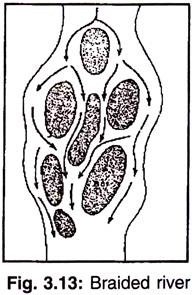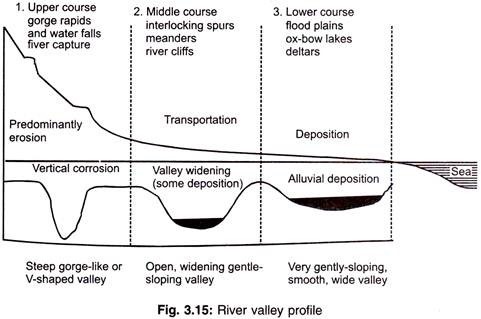ADVERTISEMENTS:
In this article we will discuss about the methods to measure run-off from rainfall over the catchment area. Also learn about the curves representing run-off data with the help of suitable diagrams.
Methods to Measure Run-Off:
1. From Rainfall Records:
In this method consistent rainfall record for a sufficiently long period is taken and then average depth of rainfall over the catchment is determined. Then considering all the factors which affect run-off process, a coefficient is arrived at for that catchment. Now a simple equation can be used to find out the run-off over the catchment.
ADVERTISEMENTS:
Run-off = Rainfall x coefficient …(15.5)
2. Empirical Formulae:
In this method an attempt is made to derive a direct relationship between the rainfall and subsequent run-off. For this purpose some constants are established which give fairly accurate result for a specified region.
Some important formulae are given below:
(a) Khosla’s Formula:
ADVERTISEMENTS:
R = P-4.811 T
where, R = Annual run-off in mm,
P = Annual rainfall in mm, and
ADVERTISEMENTS:
T = Mean temperature in °C.
(b) Inglis Formulae for Hilly and Plan Areas of Maharashtra:
For Ghat Region:
R = 0.88 P – 304.8
For plain region,
(c) Lacey’s Formula:
where,
ADVERTISEMENTS:
R = Monsoon run-off in mm,
P = Monsoon rainfall in mm,
S = Catchment area factor, and
F = Monsoon duration factor.
Values of S for various types of catchment are given below:
3. Run-Off Curves and Tables:
Each region has its own catchment area and rainfall characteristics. Thus formulae given above and coefficients derived there in cannot be applied universally. However, for the same region the characteristics mostly remain unchanged.
Based on this fact the run-off coefficients are derived once for all. Then a graph is plotted in which one axis represents rainfall and the other run-off. The curves obtained are called run-off curves. Alternatively a table can be prepared to give the run-off for a certain value of rainfall for a particular region.
4. Discharge Observation Method:
By actual measurement of discharge at an outlet of a drainage basin run-off over a catchment can be computed. The complication in this method is that the discharge of the stream at the outlet comprises surface run-off as well as sub-surface flow. To find out the sub-surface run-off it is essential to separate the subsurface flow from the total flow.
The separation can be done on an approximate basis but with correct analysis.
Curves Representing Run-Off Data:
A. Flow Duration Curve:
Refer to Fig. 15.17. Flow duration curve is another useful form to represent the run-off data for the given time. This curve is plotted between flow available during a period versus the fraction of time. If the magnitude on the ordinate is the potential power contained in the stream flow, then the curve is known as “power duration curve”. This curve is a very useful tool in the analysis for the development of water power.
The flow duration curve is drawn with the help of a hydrograph from the available run-off data and, here it is necessary to find out the length of time duration during which certain flows are available. This information either from run-off data or from hydrograph is tabulated. Now the flow duration curve taking 100 percent time on X-axis and run-off on Y-axis can be drawn.
The area under the flow duration curve (Fig, 15.17) gives the total quantity of run-off during that period as the flow duration curve is representation of graph with its flows arranged in order of descending magnitude.
If the head of discharge is known, the possible power developed from water in kW can be determined from the following equation:
where, Q = Discharge, m3/sec.,
H = Head available, m,
w = Weight density of water, N/m3, and
η0 = Overall efficiency.
Thus the flow duration curve can be converted to a power duration with some other scale on the same graph.
Flow duration curve are most useful in the following cases:
(i) For preliminary studies
(ii) For comparison between streams.
Uses of Flow Duration Curve:
1. A flow duration curve allows the evaluation of low level flows.
2. It is highly useful in the planning and design of water resources projects. In particular, for hydropower studies, the flow duration curve serves to determine the potential for firm power generation. In the case of a run-off-the-river plant, with no storage facilities, the firm power is usually computed on the basis of flow available 90 to 97 percent of the time. The firm power is also known as the primary power. Secondary power is the power generated at the plant utilising water other than that used for the generation of firm power.
3. If a sediment rating curve is available for the given stream, the flow duration curve can be converted into cumulative sediment transport curve by multiplying each flow rate by its rate of sediment transport. The area under this curve represents the total amount of sediment transported.
4. The flow duration curve also finds use in the design of drainage systems and in flood control studies.
5. A flow duration curve plotted on a log-log paper provides a qualitative description of the run-off variability in the stream. If the curve is having steep slope throughout, it indicates a stream with highly variable discharge. This is typical of the conditions where the flow is mainly from surface run-off.
A flat slope indicates small variability which is a characteristic of the streams receiving both surface run-off and ground water run-off. A flat portion at the lower end of the curve indicates substantial contribution from ground water run-off, while the flat portion at the upper end of the curve is characteristic of streams with large flood plain storage, such as lakes and swaps, or where the high flows are mainly derived from snowmelt.
6. The shape of the flow duration curve may change with the length of record. This aspect of the flow duration curve can be utilised for extrapolation of short records.
Shortcomings/Defects of Flow Duration Curve:
1. It does not present the flows in natural source of occurrence.
2. It is also not possible to tell from flow duration curve whether the lowest flows occurred in consecutive periods or were scattered throughout the considered period.
B. Mass Curve:
Refer to Fig. 15.18.
A ‘mass curve’ is the graph of the cumulative values of water quantity (run-off) against time. A mass curve is an integral curve of the hydrograph which expresses the area under the hydrograph from one time to another.
It is a convenient device to determine storage requirement that is needed to produce a certain dependable flow from fluctuating discharge of a river by a reservoir.
Mass curve can also be used to solve the reserve problem of determining the maximum demand rate that can be maintained by a given storage volume. However, it is a trial and error procedure.
The mass curve will always have a positive shape but of a greater or less degree depending upon the variations in the quality of inflow water available. The negative inclination of mass curve would show that the amount of water flowering in the reservoir was less than due to evaporation and seepage.




